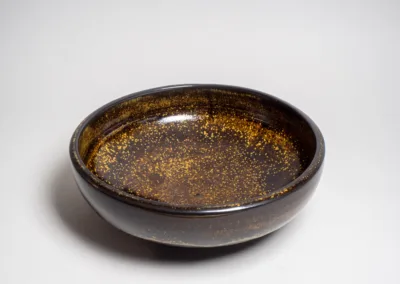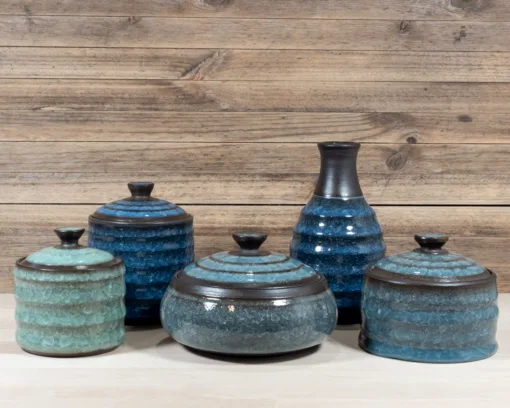Stardust
When the odds become even during the firing process the glaze develops beautiful golden microcrystals. Sometimes covering the whole ware with golden hue and other times just few golden sparks like stars.
Stardust tenmoku glaze on red or black stoneware
Sometimes this glaze appears like a stary sky with sparks of golden crystals or other times fully covered with a Golden hue creating a sense of humble luxury.
The golden effect of the glaze is achieved with special chemistry of the glaze that will produce micro crystals during the slow cooling of the kiln. There is always room for a surprise as even with the high-tech controlled kiln the result can vary from firing to firing. The surprise is also what makes using the glaze so pleasant as the result is unpredictable. Even in the same firing there can be variation of the crystallization from one edge to other extreme over-saturated crystallization.
While all the results are nice and beautiful my favorite is still somewhere in the middle, where the crystals are formed on the dark glaze background resembling the stars of dark sky.
I tend to use black and red stoneware with this glaze as they both bring out the darkness of the background. Red or black is more a matter of taste and they both work and have nice effect to add to the ware where black adds darkness and red adds softness.
Originally also known as Tea-dust glaze.
As the ice crackle glaze also tea-dust has long and old history. This glaze appeared during the times on Tang dynasty in China (618-907 AD) in the Shaanxi and Henan kilns in many different kinds of ware. During Ming dynasty (1368 – 1644) the glaze was used quite widely as well on provincial ware. During the Yongzheng period of Qing dynasty (1678 – 1735) the tea-dust glaze was adopted and revised for the use of Imperial ware in Jingdezhen.
You don’t need to think long why this glaze was used on the imperial ware.
Different styles
Ice crackle
A glaze with many names: ice crackle, tortoise shell, snowflake and many more.
Made with thick layer of crackle glaze where the fractures develop the look of cracked ice. Hence also its name – Ice Crackle.
Stardust
When the odds become even during the firing process the iron rich glaze develops beautiful golden microcrystals. Sometimes covering the whole ware with golden hue and other times just few golden sparks like stars.
Glaze that’s originally called “Tea-Dust” and was mainly used in Imperial ware.
Everyday
You come home, make tea, sit in the armchair, and catch your breath...
Here are cups, bowls and other simple dishes that give everyday life a calm, clean, modest, and rustic feel.
Made from different colored stoneware where mainly inside of the ware is glazed so that the clay itself would be brought out.





























